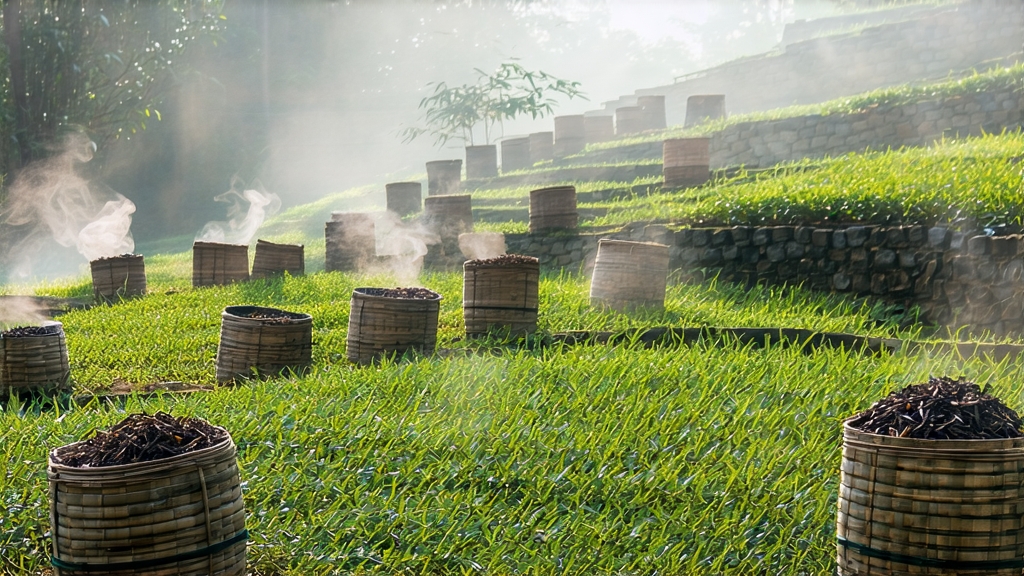
Tucked away in the southern folds of China’s Guangxi Zhuang Autonomous Region, Liu Bao tea has spent four centuries perfecting the art of quiet transformation. While Pu-erh grabs the international spotlight, Liu Bao remains the insider’s secret: a dark, glossy leaf that once traveled on the backs of horses and coolies along the Tea-Horse Road, perfumed the holds of clipper ships bound for Southeast Asia, and still ferments patiently in bamboo baskets stacked high in humid mountain warehouses. To meet Liu Bao is to taste history that has been deliberately forgotten, then gracefully remembered.
Historical Footprints
The earliest written record appears in the 1661 edition of the Cangwu County Annals, noting “black tea from Liu Bao village sold to Guangdong and Hong Kong.” By the Qing dynasty the tea had become a currency of its own, used by dockworkers in Guangzhou’s Pearl River ports to barter for rice and by Malay tin miners to ward off damp-induced fevers. When the British established the Straits Settlements, Liu Bao sailed south as ballast in tea clippers; in Singapore and Kuala Lumpur it was pressed into coin-shaped discs called “tea money” and circulated in gambling dens. World War II disrupted the trade routes, and Liu Bao retreated into domestic obscurity until the 1990s, when aging tea enthusiasts rediscovered forgotten tongs of 1950s “Zhong Cha” brand cakes selling for a song in Hong Kong’s Sheung Wan apothecaries. Prices have since doubled every few years, but the tea’s soul remains village-bound, its narrative still written in the dialect of Wuzhou.
Micro-Terroir and Leaf Styles
Liu Bao is not a single recipe but a mosaic of micro-climates within the 30-km-long Liu Bao valley. The highest gardens sit at 800 m on red lateritic soil laced with quartz; night temperatures drop 10 °C, coaxing slow growth and a high ratio of bud to coarse leaf. Farmers recognize at least six leaf styles:
- Gu Shu (ancient tree, 80–300 years old) – camphor and orchid nose, mineral finish.
- Qun Ti Zhong (heirloom seed-grown bushes) – betel-nut signature, thick liquor.
- Rattan Tea (vines trained over arbors) – honeyed jujube notes.
- Spring Tips – pale liquor, lilac aroma.
- Summer Rain – broader leaves, darker cup, hint of dried longan.
- Autumn Frost – lightest oxidation, prized for blending.
Each style is further sorted into five grades from “Special” down to “Fourth,” based on leaf integrity and stalk percentage. The top grade must contain 30 % golden buds visible against the dark backdrop like stars in a night sky.
Crafting the Darkness
Unlike Pu-erh’s sun fixation, Liu Bao begins with a 90-second high-temperature wok kill-green that locks in a subtle greenish core. The hot leaves are then rolled on bamboo trays until they “sweat” a sticky sap that smells of raw sugarcane. What follows is the defining step: wet-pile fermentation, locally called “luo dui.” Leaves are piled 70 cm high inside cement chambers, misted with mountain spring water, and covered with jute sacks. A unique microbial consortium—dominated by Aspergillus niger, Blastobotrys adeninivorans, and a rare yeast Kodamaea ohmeri—feeds on the polyphenols, raising the pile temperature to 55 °C within 36 hours. Every 24 hours the pile is turned by barefoot workers who judge readiness by aroma: the scent must shift from wet earth to dried Chinese olive with a whisper of nutmeg. After 10–18 days the leaves emerge chocolate-brown, their weight reduced by 30 %, caffeine halved, and theaflavins converted into theabrownins that gift the inky liquor.
Post-fermentation, the tea is steamed, then packed into traditional bamboo baskets called long lan—tall cylinders woven from two-year-old mao zhu bamboo that still breathes. A basket holds 40–50 kg of tea; the bamboo’s inner membrane imparts a faint green-bamboo sweetness during years of warehouse aging. The baskets are stacked cross-wise in humid caves or above-ground storehouses where summer temperatures reach 35 °C and 85 % humidity. Here the tea enters a second, slower metamorphosis: aerobic